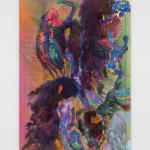-
Artworks








Black counter gravity (Carte figurative et approximative des quantités de coton en laine importés en Europe en 1858 et 1861), 2022
Oil and acrylic on archival printed canvas102 x 64 5/8 in.
259.1 x 164.1 cm$ 250,000.00SoldFurther images
-
(View a larger image of thumbnail 1
)

-
(View a larger image of thumbnail 2
)

-
(View a larger image of thumbnail 3
)

-
(View a larger image of thumbnail 4
)

-
(View a larger image of thumbnail 5
)

-
(View a larger image of thumbnail 6
)

-
(View a larger image of thumbnail 7
)

-
(View a larger image of thumbnail 8
)

For Firelei Báez, painting becomes a means of giving form to memory, evincing the idea that presence is not negated by passing. Many of her works tap into oceanic imagery...For Firelei Báez, painting becomes a means of giving form to memory, evincing the idea that presence is not negated by passing. Many of her works tap into oceanic imagery to suggest the broader history of black diaspora and the Middle Passage, in relationship to Glissant’s theory of the ocean as a connector and a repository of physical memory. This particular painting is a response to the nautical afrofuturist mythology developed by Drexciya, a Detroit-based electronic music duo. In the 1990’s, sleeve notes accompanying their techno albums described an underwater nation called Drexciya populated by a new generation of water-breathing humans: the unborn children of pregnant African women who were thrown off of slave ships and had adapted to breathe fluid within their mothers’ wombs. In Black counter gravity (Carte figurative et approximative des quantités de coton en laine importés en Europe en 1858 et 1861), Báez expands upon this counter-narrative, picturing several female figures seemingly gliding through a great ocean, echoing the Drexciya myth.
The underlying map over which these floating figures are painted shows two flow-maps of the Atlantic trade in wool and cotton, each shown three years apart. The time period covers the beginning of the American Civil War, which was sparked by the slavery policies of the Lincoln presidency. The curves of the trade routes, which shuttle across the Atlantic and hug the horn of Africa, are echoed in the forms of Báez’s figures. Here, Báez continues her work to envision the limitless-ness of Black life, joy, and genius. Through the Drexciya myth, she is able to access new ways of reconnecting and reckoning with the massacre that was the Middle Passage.Exhibitions
James Cohan Tribeca, Americananana, October 27 – December 21, 2022
Firelei Báez, ICA Boston, Boston, MA, April 4 – September 2, 2024
Firelei Báez, Vancouver Art Gallery, Vancouver, CA, November 3, 2024 – March 16, 2025
Firelei Báez, Des Moines Art Center, Des Moines, IA, June 14, 2025—September 21 2025 (forthcoming) -
(View a larger image of thumbnail 1
)







